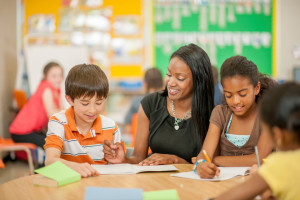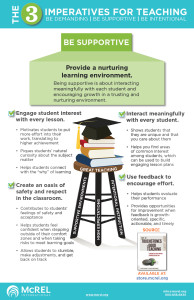
Eventually, with my grandpa’s encouragement, I learned to ride a bike. Without that support, I may have given up, feeling defeated and a bit wounded. Students can feel the same way in the classroom when they don’t feel supported, encouraged, and safe.
Being supportive is one of three key characteristics of effective teachers, along with being intentional and being demanding, that are discussed in McREL’s The 12 Touchstones of Good Teaching. Being supportive means that a teacher interacts with students and encourages growth in a trusting, nurturing environment.
There are four main ideas to keep in mind when being supportive:
Engage student interest with every lesson.
If the teacher wanted students to know why the sky is blue, she could just tell them. But they probably wouldn’t care or remember. To get students interested, rather than dispense information and call it good, my son’s fourth-grade teacher asked his class, “Why is the sky blue?” She had to know she’d get some off-the-wall answers, which she could exploit to pique students’ interest. My son obliged by exclaiming: “Because God loves the Infantry!” After a brief conversational detour to explain that his dad was a soldier and that the Infantry branch color is light blue, the science part of the lesson resumed—with the whole room engaged to a degree that a lecture couldn’t have accomplished. Other tactics I’ve heard of for reeling students into the same lesson include playing the Ella Fitzgerald song “Blue Skies” as students enter the classroom, or covering the ceiling with blue butcher paper.
Another way to engage students during lessons is to provide choices. Instead of providing one essay question to answer, you can give them three questions and they can choose to answer the one in which they have the most interest, knowledge, and confidence. You can create a quick scavenger hunt, mystery, or puzzle for students to complete that will help them discover what the next lesson will entail. Or have them first predict answers or explanations before they learn the content—which, research indicates, can boost interest and understanding.
Bottom line: Find that “hook” that will get students excited to learn.
Interact meaningfully with every student.
Very likely you have seen the video of the teacher who greets every one of his students with a unique handshake as they enter his classroom every day. He is exceptional when it comes to interacting meaningfully with every student, every day. He has shown each child that they are unique and that he cares about them as individuals.
Another way to engage with students is to make sure you know each student’s name and the correct pronunciation within the first few days of school. Show a genuine interest in your students and their lives, asking about their skills, talents, and interests. Share your experiences with them through pictures and anecdotes. You’ll not only discover unique things about each student, you’ll find areas that your interests overlap with theirs, which you can then use to engage them in lessons. Take time to sit down and listen to your students and solicit feedback from them on their learning and your teaching. Keep in mind that, unfortunately, you may be the only adult that some students will have a positive interaction with during the day. Interact, be positive, and have fun with your students.
Use feedback to encourage effort.
I was shocked, once, to hear a dynamic teacher admit she wasn’t good at providing feedback to her students but thought it was okay since her classroom was so engaging and entertaining. Having an engaging classroom is important and will help keep students’ interest high, but it is also extremely important to provide feedback for students to learn and grow. Research shows that feedback is one of the most powerful strategies to help students improve their performance.
Effective feedback is not merely saying, “Good job!” It’s about connecting the learning objectives with students’ goals. Students need to understand and buy into the fact that feedback provided by teachers, peers, and even themselves will help them improve and learn. Feedback needs to be growth-oriented, specific, actionable, and timely. If students are not given feedback promptly, then opportunities to help them develop skills or receive additional direction to complete the task will be missed. Provide explicit and descriptive feedback that is personalized for the student and includes specific guidance for future work. Show examples of previous students’ work compared to the achievement rubric so that it is very clear to current students what they need to do to find success.
Create an oasis of safety and respect in the classroom.
A student needs to feel safe and accepted to learn, so providing a positive classroom environment is critical. You can acknowledge students when they’re doing things right, and respect how they would like to receive the positive feedback (for example, writing a shy student a thank-you note if she’d be embarrassed by public praise). In one of my recent school visits, I immediately noticed the classroom rules posted on the wall, which had been written by the students themselves, with the teacher’s collaboration. Together, the entire class had signed the poster, thus committing themselves to a safe and respectful classroom.
Students need to understand that it’s okay to ask questions and give wrong answers, as that is part of learning. Within a safe and respectful classroom, students should feel comfortable taking risks, whether it is voicing their opinion while in a cooperative group, responding to a question that they are not 100% sure of the answer, or choosing to take a more challenging class. Teachers should encourage students to step outside their comfort zone and take risks in order to meet their goals. Most of all, students should know that if they stumble along the way, it’s okay; it’s not permanent failure. With their teachers’ support and guidance, they can learn from the mistake, make adjustments, and get back on track.
I was lucky to have my grandpa pick me up and run beside me with encouraging words of support and guidance that helped me learn to ride a bike. I knew that even if (and when) I fell, he would be there to help me up, dust me off, and cheer me on until I found success. As teachers, let’s make sure we’re giving our students that same support.
I’d love to hear how you support students in your classroom. Use the comment section, below, to share your ideas, questions, and comments.
In this blog post series, I will address each of the three imperatives presented in The 12 Touchstones of Good Teaching: A Checklist for Staying Focused Every Day. Look for my next post on ways to be intentional. Read my post on how to be demanding.

Even the most dedicated and experienced teachers can benefit from having a strategic checklist to boost their effectiveness. What are the 12 simple but essential things you can do every day to deliver high-quality instruction and positively impact student outcomes? Bryan Goodwin and Elizabeth Hubbell reviewed thousands of research studies, books, and articles to supply the answer in The 12 Touchstones of Good Teaching: A Checklist for Staying Focused Every Day. In addition to identifying the 12 touchstones, the authors also define three key imperatives for quality teaching and learning—be demanding, be supportive, and be intentional—and offer strategies for integrating them into classroom practice. Order The 12 Touchstones of Good Teaching from the McREL Bookstore. Learn more.

